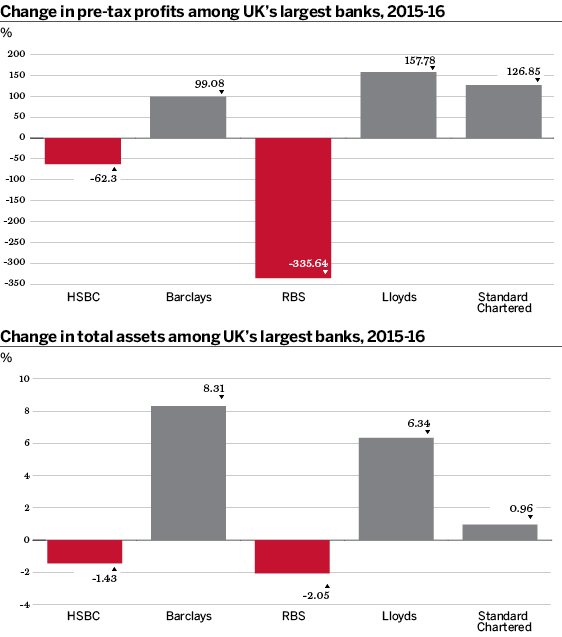The annual reports of the UK’s big five banks reveal how they emerged from 2016. Danielle Myles looks at the turbulent year’s impact on their profits and assets.
The health of the UK’s biggest banks has been revealed following the topsy-turvy year that was 2016, during which they had to deal with Brexit volatility, record-low 0.25% interest rates and a bevy of new fines.
Some banks report in US dollars and others in sterling (which lost 16.6% last year, in another challenge for their businesses) so it is unfair to compare absolute figures. Nevertheless, year-on-year changes are a good yardstick for UK banks’ relative performance.
One of the best performers was Barclays, which nearly doubled its pre-tax profits, including revenues from discontinued operations. This was fuelled by a rise in investment banking profits and lower conduct charges. Barclays made headway on its strategy to slim down and focus on key markets, selling a £600m ($746.7m) stake in its Johannesburg-based subsidiary to kick off its pull-back from Africa, and continuing to run down its non-core unit, which is expected to close in June 2017, six months ahead of schedule.
Despite this, Barclays’ total assets grew a little over 8%, from £1120bn to £1213bn, primarily due to an increase in its loans book (partly because of the depreciating pound) and liquidity pool.
Lloyds also had a good year, posting pre-tax profits of £4.24bn, up from £1.64bn in 2015. This 158% increase was driven by lower provisioning for payment protection insurance mis-selling claims, which have plagued the bank since 2011. Income in the commercial banking unit was up slightly on 2015, but at the group level income – as well as costs – were down. Net total assets increased 6.34% while risk-weighted assets (RWAs) fell by 3% to £216bn.
HSBC shock
HSBC was the year’s big surprise. The bank posted a pre-tax profit of $7.11bn, but this was 62.3% less than in 2015, ending seven years of pre-tax profit growth (bar a small dip in 2012). Meanwhile, its $46.92bn net operating income is at a level not seen since 2009 and 2010. Global Banking & Markets, HSBC’s investment banking unit, was among the better performers, increasing revenues by $353m to nearly $15bn. Total assets at the UK’s biggest bank were steady at $2375bn.
After a pre-tax loss of $1.52bn in 2015 (its first in a decade due to a hefty restructuring), emerging markets-focused Standard Chartered recovered in 2016, posting a $409m pre-tax profit. Net trading income increased from $766m to $1.89bn, but overall operating income was down 11%. Impairment losses were 41% lower than in 2015, with the biggest improvements in commercial and retail. Total assets were steady at $646.69bn, but the bank managed to reduce RWAs by 11% to $269.4bn.
At RBS, which is 73% owned by the government after its 2008 bailout, total assets declined for the fifth consecutive year (from £815.4bn to £798.66bn) in line with its restructuring into a smaller, UK-focused bank. More notable than this 2.05% fall is RBS’s 6.09% drop in RWAs (from £243bn to £228.2bn), evidence that the bank is making progress in not only shrinking, but also derisking its balance sheet. Its £4.08bn pre-tax loss marked its eighth year without recording a profit, at more than three times its 2015 loss, but far smaller than that of 2012 (£5.16bn) and 2013 (£8.24bn).
All data sourced from annual results and www.thebankerdatabase.com.



